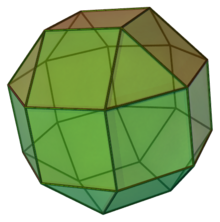This is an old revision of this page, as edited by 62.255.32.14 (talk) at 14:44, 26 May 2005 (Minor edit, sentence error). The present address (URL) is a permanent link to this revision, which may differ significantly from the current revision.
Revision as of 14:44, 26 May 2005 by 62.255.32.14 (talk) (Minor edit, sentence error)(diff) ← Previous revision | Latest revision (diff) | Newer revision → (diff)| Elongated square gyrobicupola | |
|---|---|
 | |
| Type | Johnson J36 - J37 - J38 |
| Faces | 8 triangles 18 squares |
| Edges | 48 |
| Vertices | 24 |
| Vertex configuration | 24 of 3.4 |
| Symmetry group | D4d |
| Dual polyhedron | - |
| Properties | convex, locally vertex-regular |
In geometry, the elongated square gyrobicupola is one of the Johnson solids (J37). As the name suggests, it can be constructed by elongating a square gyrobicupola (J29) and inserting an octagonal prism between its two halves. The resulting solid is locally vertex-regular — the arrangement of the four faces incident on any vertex is the same for all vertices. However, it is not truly vertex-regular, and consequently not one of the Archimedean solids, as the symmetry group of the solid does not act transitively on the vertices. Essentially, two types of vertices can be distinguished by their "neighbors of neighbors." Another way to see that the polyhedron is not vertex-regular is to note that there is exactly one belt of eight squares around its equator, which distinguishes vertices on the belt from vertices on either side.
The solid can also be seen as the result of twisting one of the square cupolae (J4) on a rhombicuboctahedron (one of the Archimedean solids) by 45 degrees. Its similarity to the rhombicuboctahedron gives it the alternative name pseudorhombicuboctahedron.
The 92 Johnson solids were named and described by Norman Johnson in 1966.